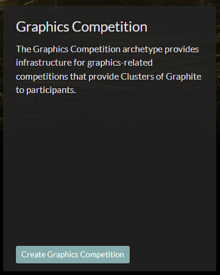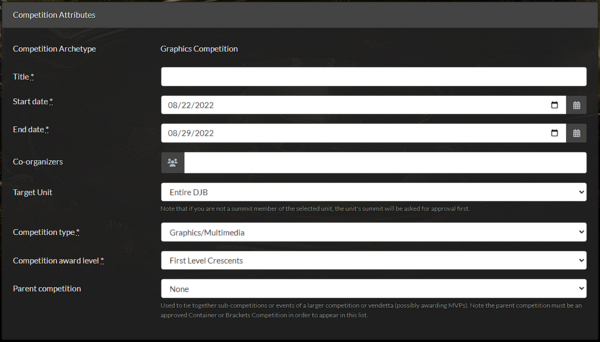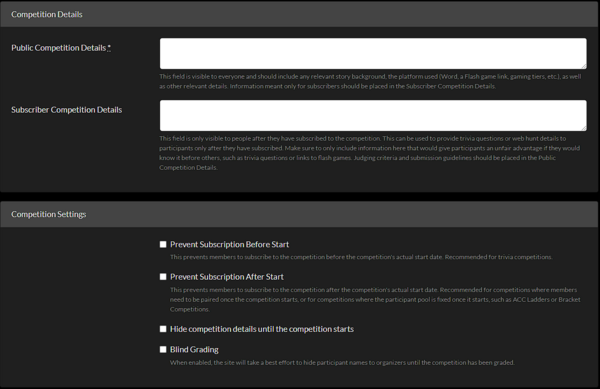This page details the process, requirements and guidelines for holding Herald-approved competitions. Examples and templates are offered to guide you through the process. This article mainly covers Graphics competitions that reward Clusters of Graphite, but also covers those that do not.
These competitions must be approved by both the offices of the Herald and MAA before they are made available to the membership.
Herald Office Competition Approval Guidelines
Creating A Graphics Competition

Competitions that award Clusters of Graphite are typically those which require original artwork as the main focus of the prompt. Original artwork includes graphics such as drawn/painted art, logos, maps, etc. and multimedia entries such as videos, music, and animations. So long as the prompt primarily involves original artwork, the competition falls under Graphics/Multimedia and should thus be created as a Graphics Competition, not Regular Competition. Also note that the competition must be connected to the Star Wars universe or the Dark Jedi Brotherhood in order to be eligible for Clusters of Graphite. The Herald’s office reserves the right to make exceptions under certain circumstances.
The image to the left shows the competition type which should be selected in order for your competition to be eligible for Clusters of Graphite. Graphics/Multimedia will be the only option in the Competition Type section. No other competition type offers Clusters of Graphite.
Once “Create Graphics Competition” is selected, you will be brought to a blank form that you must fill and then submit for approval. Each step is explained below.
Basic Information

Title: This is where you input the title of your competition. Herald-run competitions will have “HRLD” in the title which means that specific competition is sanctioned by the Herald and being endorsed under the office. In special cases, one may ask for endorsement from the Herald’s office by emailing the Herald staff mailing list. The office reserves the right to deny a request.
Start and End Date: The Start Date should be planned in advance, ideally at least 48 hours before the competition is projected to start. Otherwise, delays may occur should the competition be remanded at any level and require alterations. For the End Date, the recommended run-time for DJB-wide events is 14 to 21 days. During a Club-wide Vendetta such as a Great Jedi War or a Rite of Supremacy, member-run competitions may be remanded and/or rejected due to overlap.
Co-organizers: Input the pin of any Co-organizers here. Co-organizers are expected and required to assist in running and grading the competition.
Target Unit: Select the targeted unit. This establishes who is able to participate and place in the competition as well as the tier of crescents you are able to award under Competition Award Level.
Competition Type: Graphics/Multimedia are combined and there is only one option.
Competition Award Level: Select the highest tier of crescents you are allowed to award based on the Target Unit. This is referenced under Crescents and established by the office of the MAA. Below we offer the baseline for reference. If you have any questions, feel free to ask your Summit, the Herald Staff, and/or MAA Staff.
| Award Levels
|
| Tier
|
Target Unit
|
| Tier 1 Crescents
|
DC-run DJB-Wide Competitions
|
| Tier 2 Crescents
|
Non-DC DJB-Wide Competitions
|
| Tier 3 Crescents
|
Clan Competitions
|
| Tier 4 Crescents
|
House Competitions
|
| Tier 5 Crescents
|
Battle Team Competitions
|
Parent Competition : Select Container of Bracket competition if applicable. Used to tie together sub-competitions or events of a larger competition or vendetta (possibly awarding MVPs). Note the parent competition must be an approved Container or Brackets Competition in order to appear in this list.
The Prompt

Public Competition Details: This section should have the following details: The Prompt should include instructions, the Grading Criteria, general rules and whether or not AI-generated art is allowed. This is the meat of the competition. See the Required Elements section to learn how to create these prompts and see what information needs to be included.
Subscriber Competition Details: This section is similar to Public Competition Details, except that it is for those details that you wish to remain hidden until a member subscribes to the competition. This is particularly useful for time-sensitive competitions.
Competition Settings: Self explanatory. Ask your Summit, the Herald Staff, or the MAA Staff if you have questions concerning these settings. We recommend “Hide competition details until the competition starts”.
Difficult Settings

Difficulty Class is unique to Graphics competitions, specifically those which award Clusters of Graphite. They exist as a way to set expectations as to the quality of artwork expected and to incentivize complex prompts. They also give those members of lower skill level the ability to compete for placements without being overshadowed by their peers. There are three difficulties described below: Beginner, Intermediate and Advanced. The amount of points granted to each placement which go towards ranking up in the graphics society is set according to the chosen difficulty. The Herald staff reserves the right to request that the organizer adjusts the difficulty based on the competition prompts.
Important note: While Difficulty Class sets expectations as to the expected skill level, no member of the Target Unit will be penalized or in any way obstructed from participating in a Graphics competition, regardless of their perceived skill level. A beginner has every right to participate in a competition set to Advanced difficulty.
Breakdown of the Classes:
- Beginner difficulty: Competitions set to Beginner difficulty should have simple prompts and inclusive rules with the expectation that a new artist can achieve reasonable results. These prompts should generally allow members to draw with stick figures, and rudimentary sketches, though a minimum amount of effort should still be visible. Competitions that provide premade assets such as 3D models, doll makers, or a pre-existing line art for coloring should also be set to Beginner difficulty. If you are looking to make your competition simple, fun, and accessible, select Beginner difficulty. Beginner difficulty multiples points granted towards Society ranks at a rate of 0.75.
- Intermediate difficulty: Competitions set to Intermediate difficulty should make up the majority of Graphics competitions run in the Club. These competitions should not allow stick figures or include pre-made assets. These prompts may require a basic understanding of anatomy, proportions, and perspective as well as color theory. They may include more complex sketches, colored art, member-made 3D models, and more. If you wish your competition to test participant skills and offer more leeway for creativity, select Intermediate difficulty. Intermediate difficulty is the baseline for points granted towards Society ranks with a multiplier of 1.
- Advanced difficulty: Advanced difficulty competition prompts are meant to be challenging even for a seasoned artist. These competitions may include complex prompts such as drawing a fully-realized piece including foreground and background elements or creating a multi-panel comic strip. It may require an abundance of creativity such as inventing new creatures or spaceships. If you are looking to make your competition very hard and time consuming, or wish to give participants a major challenge, select Advanced difficulty. Advanced difficulty multiples points granted towards Society ranks at a rate of 1.25.
| Difficulty Settings
|
| Difficulty
|
Points Multiplier
|
| Beginner
|
0.75
|
| Intermediate
|
1
|
| Advanced
|
1.25
|
Required Elements
The Prompt
The first thing you need to consider when creating a prompt is the Target Unit. The prompt should be applicable and of interest to all participants. For example, DJB-wide events need to be of interest to the entire Brotherhood. It cannot be a clan-specific prompt if you expect members from another clan to participate. It needs to be a single prompt applicable to all and cannot include different options for different units as this might provide members of a specific unit an advantage over another.
The Prompt itself should be very clear and distinct from the instructions. This is where you include any fictional setup/flavor and establish in specific terms what you want the participants to accomplish. For example, “I task you to create an original piece of artwork which details a particularly emotional moment in the life of your Main or ALT character”.
The Grading Criteria
The grading criteria is required to formally establish the way by which submissions will be graded. This should include specific, unambiguous wording such as “the most humorous to the grader”, the “most creative”, or “Submissions will be graded by quality, creativity and humor in equal parts.” While it is not required, the Graphics Competition Grading Rubric is a powerful, expansive tool for grading. When using the Rubric, one can state that “Submissions will be graded in accordance with the Graphics Competition Grading Rubric” and offer a link to it. The grading criteria must be stated in the public details section of the competition.
The Instructions
The instructions or rules should clearly state the parameters of the competition. What is expected (e.g. file formats, sizes, colors, mediums, etc.), what is not expected (e.g. stick figures in Intermediate difficulty competition, etc), as well as key reasons why a participant may be disqualified (eg. wrong number of panels in a comic strip competition with a set amount of panels.) It should be clearly stated what must be included in a valid submission.
AI-Generated Images: A rule is required to establish in no uncertain terms whether or not AI-generated images are allowed. Give thorough consideration to your approach at grading AI-generated art vs member-made art. Though it is not prohibited, it is recommended not to allow AI-Generated art for competitions set to Advanced difficulty.
Fair-Use Clause: Any photo-manipulation artwork or multimedia project containing fair-use images (any image not owned by the member) must include links to source images and credit to the original author (within reasonable applicability) to be considered valid. Disqualifications or invalid entries will not be granted clusters. The instructions should include a note that members are required to cite the aforementioned sources and credits for images used in their work which are not their own.
Documentation: When DJB-wide events are being judged, the grading rubric must be filled out for each entry. The Herald’s Office reserves the right to verify these as needed. They should also be made available to those seeking feedback on their work.
Graphics Competition Template
This is a standardized template the Herald staff has provided to help members in making their own competitions:
*Prompt: (Insert prompt here. Be clear and detailed to ensure that participants understand the task at hand.)
*Other Important Information: (Include other details required by the participant such as links to wiki pages, etc.)
*Acceptable formats: .PNG, .JPG, .PDF
*AI-generated: (State in no uncertain terms whether or not AI-generated art is allowed for your competition)
*Useful Tools: GIMP, Photoshop, Krita, Paint Tool Sai
*Grading Criteria: (Include how you will grade the competition, e.g. the Herald Graphics Grading Rubric.)
Note: All entries must be original artwork and if any resources are used that are not original must be cited in the submission box.
Non-Applicable Graphics Competitions
There are types of Graphics-based competitions that do not meet the above criteria and do not apply to the graphics society. The best examples are Meme and Battleplan competitions, both of which require a certain amount of graphics work but do not count towards Clusters. In such cases, one must refer to MAA policies and create a Regular Competition instead of a Graphics Competition.
If you have any questions concerning these, please contact your clan summit, the Herald Staff, and/or the MAA Staff.
Updates
- Policy text and competition template updated and QoL features added by Malfearak Asvraal on 02/11/2024